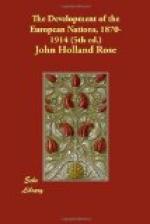[Footnote 129: Hertslet, vol. iv. p. 2625.]
Thus the general situation in the spring of 1877 scarcely seemed to warrant the hopes with which the Turks entered on the war. They stood alone confronting a Power which had vastly greater resources in men and treasure. Seeing that the Sultan had recently repudiated a large part of the State debt, and could borrow only at exorbitant rates of interest, it is even now mysterious how his Ministers managed to equip very considerable forces, and to arm them with quick-firing rifles and excellent cannon. The Turk is a born soldier, and will fight for nothing and live on next to nothing when his creed is in question; but that does not solve the problem how the Porte could buy huge stores of arms and ammunition. It had procured 300,000 American rifles, and bought 200,000 more early in the war. On this topic we must take refuge in the domain of legend, and say that the life of Turkey is the life of a phoenix: it now and again rises up fresh and defiant among the flames.
As regards the Ottoman army, an English officer in its service, Lieutenant W.V. Herbert, states that the artillery was very good, despite the poor supply of horses; that the infantry was very good; the regular cavalry mediocre, the irregular cavalry useless. He estimates the total forces in Europe and Asia at 700,000; but, as he admits that the battalions of 800 men rarely averaged more than 600, that total is clearly fallacious. An American authority believes that Turkey had not more than 250,000 men ready in Europe and that of these not more than 165,000 were north of the Balkans when the Russians advanced towards the Danube[130]. Von Lignitz credits the Turks with only 215,000 regular troops and 100,000 irregulars (Bashi Bazouks and Circassians) in the whole Empire; of these he assigns two-thirds to European Turkey[131].
[Footnote 130: The Campaign in Bulgaria, by F.V. Greene, pt. ii. ch. i.; W.V. Herbert, The Defence of Plevna, chaps, i.-ii.]
[Footnote 131: Aus drei Kriegen, by Gen. von Lignitz, p. 99.]




